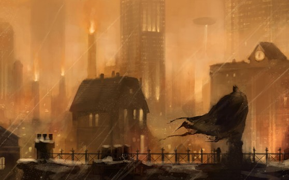I figured I'd make a thin rectangle with 13 horizontal subdivisions for the stripes and a bunch of vertical subdivisions so I can put some non-flat positioning into the flag. Coloring the horizontals should be trivial, and I could apply a jpeg with stars on a blue field to the upper left field, I figured. A few spotlights on the flag, a directional light to illuminate the scene, and a couple of buildings in the background for the flag to cast shadows onto and I'd be set.
I built the basic shapes, then worked on the flag, applying a red Blinn texture to the red stripes and a slightly off-white Blinn to the other stripes. I removed the area I wanted blue and used Mesh>Fill Hole to put one big blue (Blinn) square in the upper left corner of the flag. A couple of colored spots and a directional light, save it and render it. Everything so far worked as I expected; it looked okay. So far, so good. I saved it and closed it up.
When I opened it, several of the flag elements were the wrong color, despite the Attribute Editor telling me the proper texture was applied. I rendered it to make sure they were not just a display glitch, and sure enough, they rendered the wrong color. I tried reapplying the correct texture/color, with no effect. In the process, I noticed there were four subdivisions on the back of the flag that had turned blue; when I tried to apply the whitish Blinn to them, all the white stripes turned blue. After a few unsuccessful tries at fixing both of those problems, I resolved to go ahead with the flaws unfixed, for the sake of my blood pressure.
Here is a render, from the saved file of my first session with this model:
Ironically, it worked this time (after I gave up on it).
The model, however, is still badly flawed. Here's a screen shot of the model that rendered as above. Note the wrongly-colored parts of the bottom red stripe:
Then I tried to follow the instructions in Miles's instructional videos, but couldn't figure out why we were importing an image into the image plane, so I tried to see what the heck an "image plane" was, but Maya's Help Files never tell us. I couldn't see how to bring up the Attribute Editor for the Image Plane except when importing a graphic into it, which meant abandoning changes and reopening the saved version until it did what I wanted; associated a UV map (a couple of stars on a blue field) with the blue rectangle. When I finally got the rectangle to acknowledge the stars, the white stripes had again turned blue -- all, that is, but the parts of the stripes that had gone checkerboard blue and red, and the missing faces in the bottom row. And the stars did not appear in the blue rectangle, as i thought they should. Here is a screen shot of that:
Mangled Flag.jpg
In addition to the color issues, many faces from the bottom row went missing. You can't really see it in the above picture, so here it is angled so you can see what happened to the bottom row:
Mangled Flag Angled.jpg
I wondered what could possibly have happened. Whatever it was I was sure I hadn't done anything that should have led to that result.
I put it away and wrote this in frustration.
It's pretty clear to me now that Maya and I are never going to get along.















